This was published 5 years ago
Walled City, Hong Kong: The incredible story of the lawless enclave inside Hong Kong
By Penny Watson
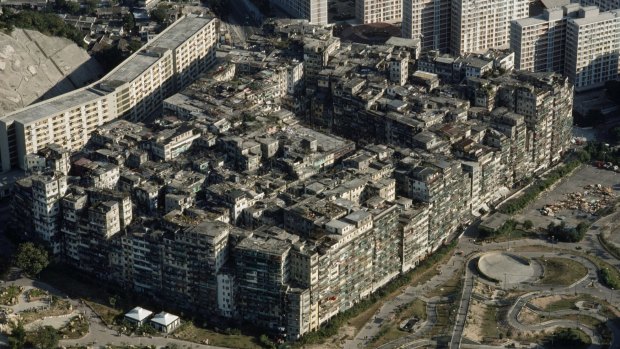
At its peak, the Walled City had the dubious accolade of being the most densely populated place on Earth.Credit: Getty Images
In the Hong Kong suburb of Mong Kok, you'd be hard-pressed to spin on one foot without knocking someone sideways, such is the limitation on personal space in this densely populated urban pocket.
Think then, of the crush of humanity in the nearby Kowloon Walled City, which, at its most populated peak, had the dubious accolade of being the most densely populated place on earth.
Within the 2.8-hectare clutch of land, 30,000 to 40,000 people eked out an existence. The real figure, given the city's ungoverned status, was likely far higher.
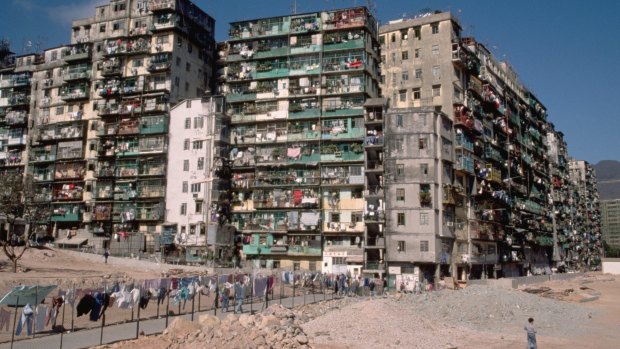
By the late '60s, the space had evolved into a mass of almost 300 illegally constructed residential towers.Credit: Getty Images
These days, the notorious Walled City has been replaced by Kowloon Walled City Park. Its mosaic pebbled walkways, tiled-roof Chinese pavilions, waterfall rockeries and tree-pocked grassy knolls are the setting for wedding photos and magazine shoots where models in traditional costume stare dreamily into the distance.
But the pervasive fascination and wild west-style nostalgia for the Walled City remains, and the park, open free of charge to visitors, is helping keep it alive.
In the early 1800s, the land here functioned as a small fort overlooking Kowloon Bay. Over the following years the Chinese and British governments played tug-of-war over ownership. In 1842, when Hong Kong Island was ceded to the British, the Qing Dynasty authorities added a formidable stone defensive wall to keep tabs on its British neighbours.
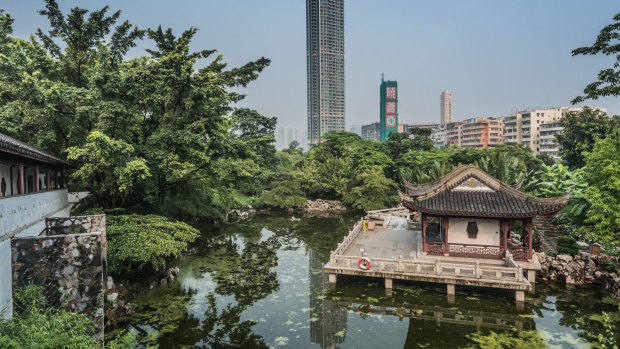
The Walled City has now been replaced by Kowloon Walled City Park. Its mosaic pebbled walkways, tiled-roof Chinese pavilions, waterfall rockeries and tree-pocked grassy knolls are the setting for wedding photos and magazine shoots.Credit: SHUTTERSTOCK
In 1898, when the New Territories (part of the Chinese mainland) was handed to Britain for 99 years, the Walled City was exempted, but at the end of the Qing Dynasty in 1912 the British claimed ownership.
After World War II and the Japanese surrender, the Walled City was back in Chinese hands as a home to 2000 mainland Chinese seeking refuge on British soil.
The British Government again claimed ownership but adopted a largely hands-off policy, which paved the way for three to four decades of unregulated infrastructure, lawlessness and a population explosion.
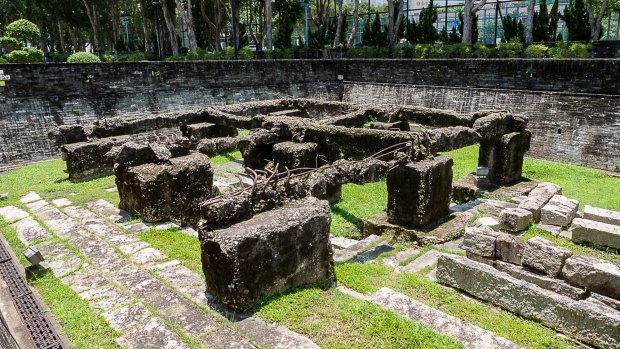
Some of the ruins left behind from the Walled City in the park.Credit: SHUTTERSTOCK
The stone from the original fort wall has all but gone. It was used by the Japanese during World War II to expand the nearby Kai Tak Airport runway, but another lesser wall running around the park indicates just how tight the boundaries were.
By the late '60s, the space within it had evolved into a cheek-by-jowl mass of almost 300 illegally constructed and haphazardly built residential towers, many of them topping 13 or 14 storeys.
These higgledy-piggledy structures, woven together by an interconnecting maze of passageways and staircases, and topped with television antennae and washing lines, were so closely knitted that only about 5 per cent of the city ever saw direct sunlight.
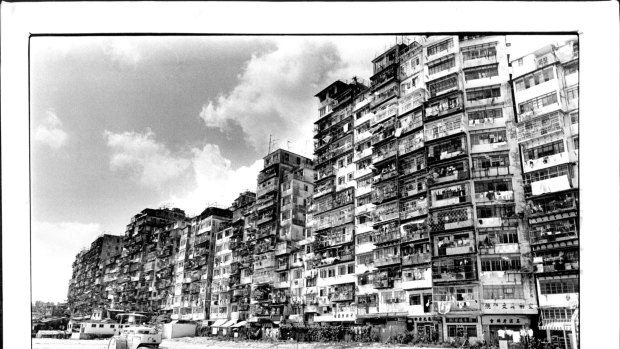
A 1985 photo of the Walled City. A joint agreement between the Chinese and British Governments in 1987 laid the groundwork for residents to be moved to public housing and in 1993 the Walled City was bulldozed.Credit: Fairfax Media
Armie Ma, my guide from Walk in HK Tours, which runs a three-hour cultural tour in and around the Walled City Park, says: "New layers were simply erected upon old layers. The rooftops would have gone higher if they weren't limited by Kai Tak Airport's low-flying planes.
"Kai Tak's only runway was not far from the Walled City and it was one of the busiest airports in the world. When planes took off, they made a 45-degree turn directly above it. Kids playing on the rooftops could literally wave to inflight passengers."
The unregulated buildings were a match for the general lawlessness and the city earned names including "Sin City" and "City of Darkness". Aided by the government's turn-a-blind-eye policy, Triad groups were at liberty to run brothels, casinos and opium dens. Crime was rampant.
Ma says: "And there were no police patrolling the city. If they had to go in, police would attend in big numbers – 30 or so at a time, but only for something serious, like murder."
A walk through the park reveals the original fort's restored yamen or administrative building, which stood as the only single-storey structure at the heart of the city. Other salvaged curiosities include the old stone sign from the southern entry.
An intriguing copper model of the city has been built to scale, offering park visitors a bird's-eye view of just how densely packed the buildings were.
An intricately detailed illustration of a cross-section of the city, by Hilomi Terasawa, goes further. It reveals the daily lives of the community living within and their struggles in the slum-like conditions. Unlike the rest of Hong Kong, there were no electricity or sewage systems, and water supply was limited to three taps where a queue of people stood constantly waiting for water.
Ma says: "Lining up for water was such a time-consuming chore that it became one of the paid jobs within the city."
Terasawa's illustration shows residents walking around with umbrellas, not to avoid the rain or tropical heat, rather the constant stream of dirty water coming from above. Electricity, stolen from street lights outside the city, was transferred via a complex and dangerous network of cables. This, combined with layers of garbage, meant fires were common.
The artwork also depicts this city's community groups and services, including unregulated hospitals and schools and unlicensed doctors and dental clinics. Trades and small businesses also operated with its walls. Ma mentions anecdotally that eight out of 10 fish balls eaten in Hong Kong during the '60s were made in the Walled City.
Children grew up here, and multiple generations of families called it home.
When the law was stepped up in the '70s and '80s the crime subsided. Community activists started demanding more for the city and its residents. Government services, such as post and water, were introduced, but ongoing sanitation problems and issues from decades of unregulated building persisted.
A joint agreement between the Chinese and British Governments in 1987 laid the groundwork for residents to be moved to public housing and in 1993 the Walled City was bulldozed.
Costing a whopping $HK76 million in an area not considered in need of a green space, the Kowloon Walled City Park remains as a reverent nod to a slice of Hong Kong's absorbing history and a means of keeping poignant memories alive.
Trip Notes
MORE
TOUR
Walk in Hong Kong Tour's private, three-hour Kowloon Walled City and Food Adventure costs HKD2600 for one to two adults and includes guide fee and all food tasting. See http://walkin.hk/tours/kowloon-city/
Entry to Kowloon Walled City Park is free.
See also: Living in cages: Dark underbelly of Hong Kong exposed to tourists
Sign up for the Traveller Deals newsletter
Get exclusive travel deals delivered straight to your inbox. Sign up now.